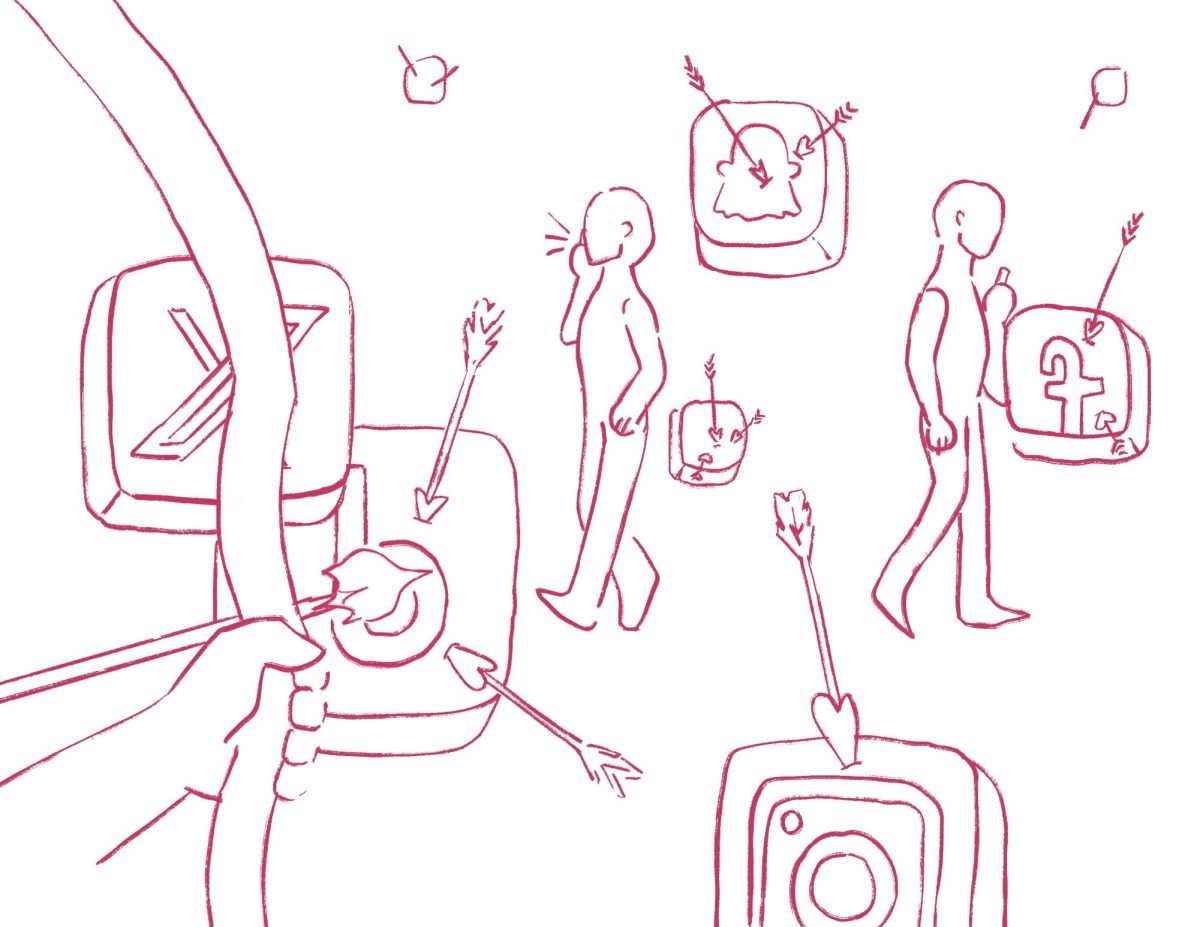Yes, It Has
By Matthew K. ’28
What is Love? (Baby, Don’t Hurt Me)
Okay, but seriously — what is love? It’s a question philosophers have debated for centuries, lumped in with the other great mysteries of life, like consciousness, morality, and free will. But what it most certainly isn’t — despite what the internet might have you believe — is liking each other’s Instagram stories, swiping right on Tinder, or the endless stream of “Couple Goals” splashed across Pinterest boards. Love isn’t the highlight reel of a relationship — the carefully curated five or six photos selected from hundreds of selfies or the overly staged “candid” moments. It isn’t a competition to appear more interested in a text-based conversation or a battle for validation through likes and comments. And it certainly isn’t disposable. Yet, that’s exactly how modern culture seems to treat it.
The scientific consensus holds that love is a fundamental part of human nature. We’re wired to seek connection, bond with others, and love deeply. And yet, how we experience love today looks drastically different from just a few decades ago.
In 1990, 29% of Americans were single — neither married nor living with a partner. Today, that number has risen to 38%, a shift often attributed to cultural individualism. This growing emphasis on self-reliance and independence isn’t inherently bad, but it exists alongside another, newer force: the internet. Together, they’ve redefined how we approach relationships — and not for the better.
Thirty years ago, love thrived on privacy and effort. Relationships were built through shared moments, personal growth, and face-to-face communication. There were no Instagram feeds to curate, no public declarations of affection meant to collect likes, and no endless options waiting on a dating app. Love required patience, vulnerability, and commitment. It wasn’t about appearances; it was about actions.
Today, relationships have become performances. The internet invites us to share our happiest moments with the world, creating a public narrative for what is, at its core, a deeply private experience. The problem is that this curated version of love often sets unrealistic expectations. Every post, story, and couple’s photo becomes an opportunity for comparison. Suddenly, your real-life relationship — messy, imperfect, and human — feels inadequate next to the filtered perfection scrolling across your screen.
It’s undeniable that the internet has changed how we think about love and relationships. Platforms like Instagram and Tinder have made meeting people easier, but they’ve also commodified love. Dating apps reduce potential partners to profiles, and social media encourages a culture of superficial validation, where the success of a relationship is measured in likes, comments, and engagement.
Some might argue that these tools help people connect — and they’re not wrong. Long-distance couples, for example, benefit immensely from platforms that allow them to stay in touch across time zones. The internet has also created spaces for people to find community and support, but even these benefits come with a cost.
The very platforms that foster connection are designed to demand constant attention. Notifications, algorithms, and the addictive nature of likes pull us away from the real work of building relationships. Love, at its core, isn’t built in the gaps between notifications. It requires time, presence, and focus — increasingly rare qualities in our distracted, digital age.
Here’s the paradox: we’re more connected than ever, yet more people are single. We have endless tools for communication, yet forming deep, lasting relationships feels harder.
Social media has created a world where love competes with distractions, comparisons, and the illusion of perfection. It encourages individualism to the point where vulnerability — the foundation of any meaningful relationship — feels risky or even unnecessary. While previous generations faced their own challenges in love (think back to the stigma of interracial marriage or same-sex relationships), the struggles of today’s relationships are uniquely shaped by technology. The very tools that promised to bring us closer have, in many ways, pushed us apart.
So, what’s the solution? It starts with redefining what love means to us — not as a performance or a commodity, but as a deeply human experience. It means recognizing that the best moments in a relationship are often the ones that go unshared, the private jokes, the quiet nights, and the messy, unfiltered realities. It also means taking a critical look at how we use social media and the internet. The platforms themselves aren’t inherently bad, but they’re tools, not substitutes for real connection. By being intentional with our use of technology, we can foster healthier relationships — ones built on trust, communication, and genuine care.
Stay authentic, Lakesiders.
No, it Has Not
By Oliver T. ’28
Once upon a time, finding love entailed dropping a bouquet of flowers on a doorstep, scanning the room for a stranger’s lingering gaze, or waiting weeks for a reply to a heartfelt love letter. Today, social media has allowed us to explore new levels of authenticity when finding love — sending that one reel that you’ve saved for the perfect moment in a conversation, double-tapping on a post, or even just swiping right.
Social media has boundlessly enriched the experiences of modern romance and finding love. To be clear, there was still plenty of value and beauty in analog romance, and the widespread use of social media has arguably romanticized using more traditional methods of flirting and expressing love. What this article seeks to establish is that social media has at best greatly benefited modern romance, and at worse, not been detrimental to it.
Take long-distance dating, for example. Social media has made it infinitely easier for couples far away from each other to maintain their relationships. Some may argue that social media calls for constant attention and is measured solely by the number of likes/other metrics, but true love withstands the test of time and is decoupled from all social media metrics. In a trusting relationship, a lack of constant attention — such as being left on “delivered” for an extended period of time — does not decrease the affection between two people or the quality of the relationship. To cite the Mind and Body Counseling Associates, “Couples now have the chance to connect visually and emotionally, making distance seem less formidable.”
Fast-changing times call for new methods of finding love, and that’s exactly why dating platforms such as Tinder, Bumble, and Hinge exist. Today, social expectations are vastly different from what they looked like in previous generations. Specifically, popular concepts such as “finding the one,” the “soulmate” myth, the rise of individualism, and evolving gender roles, have resulted in a need to create new avenues for finding love.
Dating apps are the perfect solution, offering unparalleled efficiency while choosing from a massive pool of potential loved ones, who you can reject or accept with the swipe of your finger.
Social media also bridges geographical and cultural barriers, fostering connections across a variety of languages and backgrounds.
Admittedly, modern romance, especially in the earlier stages of a relationship, can be difficult to navigate through social media due to unrealistic expectations and an increased fear of vulnerability. However, it can be worth it. As author Aziz Ansari writes in his book, Modern Romance: An Investigation, “Finding someone today is probably more complicated and stressful than it was for previous generations — but you’re also more likely to end up with someone you are really excited about.”
Social media also fosters deeper connections by adding new dimensions to relationships. Whether it be through joining Facebook groups because of a common interest, tagging each other in posts, or posting Instagram notes with an underlying message, social media allows couples to diversify their expressions of love and maintain their connection in a variety of ways.
This is true among high schoolers, where there is often an abundance of peer pressure, embarrassment, and judgment that can come with being in a public relationship in a space where you see the same faces for 180 days a year. Social media allows couples to express their love through new avenues.
In today’s increasingly toxic society, it’s important to keep in mind that although social media is a great facilitator for long-distance relationships, it brings people together in real life as well. For example, in 2019, then-presidential candidate Pete Buttigieg revealed that he met his current husband on the popular dating platform Hinge. Social media is a springboard to bring online connections to life, and it brings a wider community of people to the table. In the pre-social media era, people often relied on going to events, bars, or clubs to meet new people. Social media has changed that.
Love, both online and offline, has its imperfections, but it’s important that we embrace both mediums, since the integration of technology into our lives is inevitable.
Embrace the future, Lakesiders.

